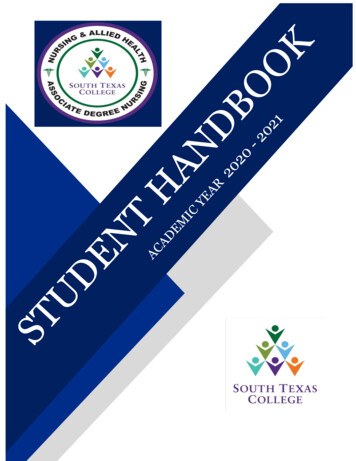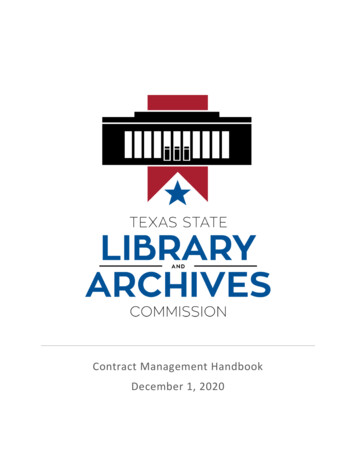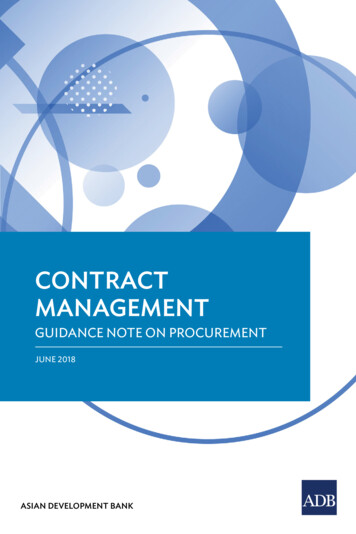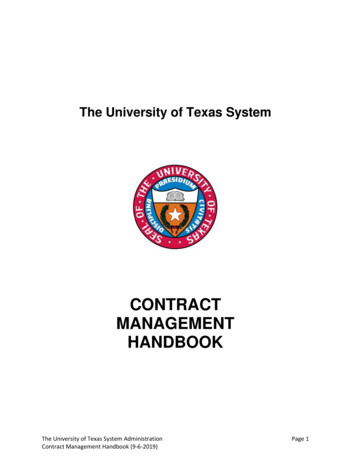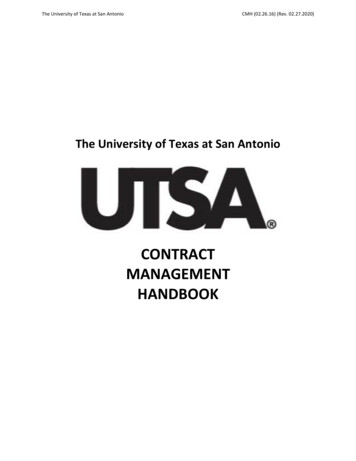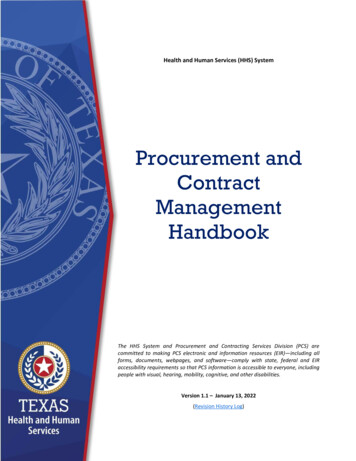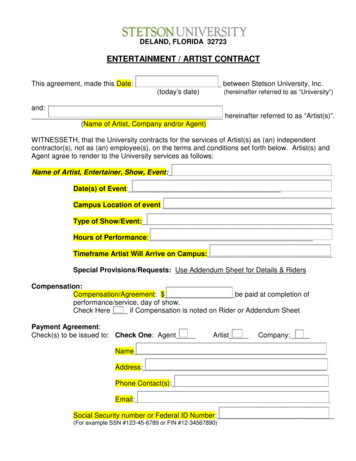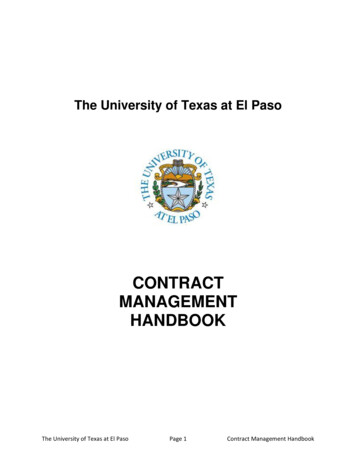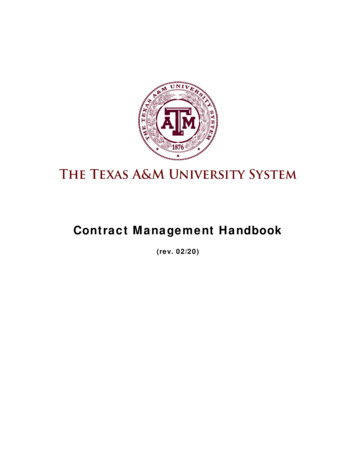
Transcription
Contract Management Handbook(rev. 02/20)
Table of ContentsSection 1 – IntroductionSection 2 – PurposeSection 3 – This HandbookSection 4 – Code of EthicsA. GeneralB. State Ethics PolicyC. Standards of ConductD. Prohibition of Economic BenefitE. The Texas A&M University System Ethics PolicySection 5 – Conflict of InterestA. GeneralB. The Texas A&M University System Conflict of Interest PolicySection 6 – PlanningA. Risk AssessmentB. Risk ManagementC. Determining Procurement MethodD. ExemptionsE. Other Planning ConsiderationsF. Planning for GrantsSection 7 – Preparing and Advertising the SolicitationA. Statement of WorkB. Advertising the SolicitationSection 8 – Evaluation and AwardA. Evaluation TeamsB. Responsive ProposalsC. Single ResponsesD. Proposal EvaluationE. PresentationsF. AwardG. NegotiationsH. Evaluation and Award of GrantsSection 9 – Contract FormationA. LegalB. Drafting the ContractC. Contract Review ChecklistD. Authority to ContractE. Federally Funded ContractsF. Contract Formation for GrantsSection 10 – Contract AdministrationA. Contract Manager ResponsibilitiesB. Posting of ContractsC. Contract ReportingD. Contract MonitoringE. Payment ApprovalF. Change ManagementG. Dispute ResolutionH. Termination2 Page
I. Contract Close-outJ. Grant Close-outK. Contract Administration FileL. Retention PolicySection 11 – Training and Continuing EducationA. Purchasing PersonnelB. Contract Management PersonnelSection 12 – DefinitionsSection 13 – AcronymsSection 14 – Appendix3 Page
Section 1 – IntroductionContract management is the coordination and management of four core processes: PlanningProcurementContract Formation (Rate/Price Establishment and other relevant terms and conditions)Contract AdministrationTexas law governs certain aspects of contracting for state agencies. Various types of purchases and contracts maybe subject to different statutory standards, practices, processes, and strategies for successful implementation.The suggestions, comments, techniques, examples and recommendations included in this handbook are NOTappropriate for every type of contract. The nature and level of risk associated with each of these elements varydepending on the nature of the business relationship.Section 2 – PurposeThe purpose of the Contract Management Handbook (CMH) is to provide each of the universities and agencies ofThe Texas A&M University System (Members), their contract managers and purchasing personnel guidance anddirection on contract management processes and practices. The CMH is not designed to relieve the Member orits contractors/suppliers of their responsibility to ensure compliance with laws, rules, and regulations related totheir specific programs and funding sources.A Contract Review Guidelines and Checklist has also been developed to identify steps used to evaluate and processcontracts to be signed on behalf of the System or System Members. This checklist can be found at the followinglink; ract-administration/Section 3 – This Handbook Has been created to provide suggestions as well as best practices to improve Member contractingprocesses.Describes the processes within contract administration, including how to develop and negotiate acontract, select a contractor and monitor contractor performance.Describes the procurement process as it relates to contract administration and management.Does not replace existing statutory requirements and Member rules, policies or procedures. EachMember is responsible for developing sound business procedures in accordance with applicable state andfederal laws, regulations, policies and procedures.Is not intended to be a manual on the law of contracts or constitute legal advice. General principles of lawwill be discussed, but these are only general principles which include many exceptions. ALWAYS CONSULTTHE OFFICE OF GENERAL COUNSEL FOR LEGAL ADVICE CONCERNING CONTRACTS.Includes sample contract provisions, distinguishing between essential, recommended and optionalcontract provisions.4 Page
Section 4 – Code of EthicsA. GeneralState officials and employees are responsible for protecting the safety and welfare of the public’s monies. Allstate officials and employees should endeavor to pursue a course of conduct that does not raise suspicionamong the public. Therefore, they shall avoid acts which are improper or give the appearance of impropriety.This conduct is particularly important for state purchasing personnel and contract management personnelwho are charged with the disposition of state funds.State purchasing personnel must adhere to the highest level of professionalism in discharging their officialduties. The nature of purchasing functions makes it critical that everyone in the purchasing process remainindependent and free from the perception of impropriety. Any erosion of public trust or any shadow ofimpropriety is detrimental to the integrity of the purchasing process. Consequently, the credibility of apurchasing program requires that a clear set of guidelines and rules be established. Such guidelines aredesigned to prevent actual and potential vendors from influencing state officers or employees in dischargingtheir official duties. Furthermore, these guidelines will help prevent state officials’ and employees’independent judgment from being compromised.Therefore, with these principles in mind and in accordance with state law, the following policies andprocedures should be adhered to by all state agency employees, contractors and potential contractors.B. State Ethics PolicyIt is the policy of the State of Texas that a state officer or state employee may not have a direct or indirectinterest, including financial and other interests, or engage in a business transaction or professional activity, orincur any obligation of any nature that is in substantial conflict with the proper discharge of the officer’s oremployee’s duties in the public interest.C. Standards of ConductA state officer or employee should not:a. Accept or solicit any gift, favor, or service that might reasonably tend to influence the officer or employeein the discharge of official duties or that the officer or employee knows or should know is being offeredwith the intent to influence the officer’s or employee’s official conduct;b. Accept other employment or engage in a business or professional activity that the officer or employeemight reasonably expect would require or induce the officer or employee to disclose confidentialinformation acquired by reason of the official position;c. Accept other employment or compensation that could reasonably be expected to impair the officer’s oremployee’s independence of judgment in the performance of the officer’s or employee’s official duties;d. Make personal investments that could reasonably be expected to create a substantial conflict betweenthe officer’s or employee’s private interest and the public interest; ore. Intentionally or knowingly solicit, accept or agree to accept any benefit for having exercised the officer’sor employee’s official powers or performed the officers or employees official duties in favor of another.5 Page
D. Prohibition of Economic BenefitIn accordance with the Texas Constitution an officer or employee of the state may not, directly or indirectly,profit by or have a pecuniary interest in the preparation, printing, duplication, or sale of a publication or otherprinted material issued by a department or agency of the executive branch. A person who violates this sectionshall be dismissed from state employment.E. The Texas A&M University System Ethics PolicyFor specific policies related to Ethics within The Texas A&M University System please .edu/07-03.pdfSection 5 – Conflict of InterestA. GeneralTo avoid conflicts of interest state agencies shall require all potential contractors to disclose, in their responsesto solicitations, any actual or potential conflicts of interest in their proposed provision of services or otherperformance under any contracts resulting from the solicitations. Specifically, principals of debarred vendors(i.e. owner, proprietor, sole or majority shareholder, director, president, managing partner, etc.) shall beidentified to ensure such vendors/principals are not awarded, extended or renewed any contract. Further,respondents should also be required to update that information throughout the terms of any contractsresulting from the solicitations. In cases where there is no solicitation the contract shall include a clauseaddressing contractor disclosure of conflict of interest. See Appendix (Section 14.E).B. Agreements with Former or Retired EmployeesAdditionally under Section 2252.901, Texas Government Code, agencies may not enter into employmentcontracts, professional services contracts or consulting services contracts under Chapter 2254 with former orretired employees before the first anniversary of the last date on which the individual was employed by theagency if appropriated funds are used to make payments under the contract.C. TEC Disclosure of Interested Parties (Form 1295)Further, effective January 1, 2016, a contracting business entity must submit a disclosure of interested partiesform prescribed by the Texas Ethics Commission to Members for any contract (including an amendment,extension, or renewal) that has a value of at least one million dollars or requires action by the Board ofRegents, unless it falls into one of the following categories: a sponsored research contract of an institution of higher education; an interagency contract of a state agency or an institution of higher education; a contract related to health and human services if:o the value of the contract cannot be determined at the time the contract is executed; ando any qualified vendor is eligible for the contract;6 Page
a contract with a publicly traded business entity, including a wholly owned subsidiary of the businessentity;a contract with an electric utility, as that term is defined by Section 31.002, Utilities Code; ora contract with a gas utility, as that term is defined by Section 121.001, Utilities Code.A “contracting business entity” includes a sole proprietorship, partnership, corporation, limited liabilitycompany, nonprofit entity, foreign company, or other legally-recognized business entity other than thosegovernmental entities indicated above. Information regarding contracts that require Board action can befound at http://policies.tamus.edu/25-07.pdf. The Member may not execute a contract until the entityprovides the form. Further, no later than 30 days after the full execution of the contract the Member mustprovide the form’s certification number to the TEC as described on the TEC website. More ps://www.ethics.state.tx.us/whatsnew/elf info form1295.htm, documents in Appendix G and H, or bycontacting the Office of General Counsel.Members shall also require respondents to: Represent and warrant that their provision of services or other performance under the agreement willnot constitute an actual or potential conflict of interest and represent and warrant that it will notreasonably create even the appearance of impropriety.Disclose any current or former employees who are current or former employees of the Member.Disclose any proposed personnel who are related to any current or former employees of the Member.Represent and warrant that they have not given, nor intend to give, at any time hereafter, any economicopportunity, future employment, gift, loan, gratuity, special discount, trip, favor or service to a publicservant or employee or representative of the State of Texas in connection with the solicitation.Note: these items shall be included as a statement within a contract/PO if no solicitation was issued.Contractors should not be allowed to assign any portion of the contract or their performance, to others, forexample, to subcontractors; without the prior written consent of the Member. Contractors remainresponsible for the performance of the contract notwithstanding any such assignment or subcontract. Thisensures that the evaluated and selected entity will actually be responsible for performance and that proposedtransactions may be reviewed for compliance with the conflict of interest and related party provisions.D. Nepotism Disclosure StatementGovernment Code 2262.004 states that prior to award of a contract for the purchase of goods or servicesvalued at 1 million or more, each of the agency's purchasing personnel working on the contract must disclosein writing any relationship they are aware about that the employee has with an employee, a partner, a majorstockholder, a paid consultant (with a contract with the business entity the value exceeding 25,000), or otherowner of the business entity that is within a degree described by Section 573.002. This disclosure should bemade to the administrative head of the state agency."Purchasing personnel" means an employee of a state agency who makes decisions on behalf of the stateagency or recommendations regarding:(A) contract terms or conditions on a major contract;7 Page
(B) who is to be awarded a major contract;(C) preparation of a solicitation for a major contract; or(D) evaluation of a bid or proposal.E. Vendor Compliance Verificationsa. Contract Manager or Purchaser must check the debarred vendor list posted on the CPA website toestablish that the vendor has not been debarred by. An agency may not award a contract to a debarredvendor.b. Contract Manager or Purchaser must check the System for Award Management (SAM) database to verifythat a vendor is not excluded from grant or contract participation at the federal level. A contract cannotbe awarded to a vendor named on the U.S. Treasury Department, Office of Foreign Assets Control’s masterlist of Specifically Designated Nationals & Blocked Persons.c. Government Code 2252.152 states that agencies may not contract with a company doing business withIran, Sudan or a foreign terrorist organization. Prior to award, the Agency must check the divestment listto determine if the potential awardee is in violation of this requirement. The divestment lists aremaintained by the Texas Safekeeping Trust Company and posted to the CPA website.F. The Texas A&M University System Conflict of Interest PolicyAdditional detail regarding Conflict of interest as related to procurement is included in a later section of thiscontract management handbook.For specific policies related to Conflict of Interest within The Texas A&M University System please visit: Conflict of Interest:o http://policies.tamus.edu/07-03.pdfo http://policies.tamus.edu/07-01.pdfConflict of Commitment:o http://policies.tamus.edu/07-01.pdfo http://policies.tamus.edu/31-05-02.pdfOutside Activities:o http://policies.tamus.edu/31-05.pdfo http://policies.tamus.edu/31-05-02.pdfSection 6 - PlanningA. Risk AssessmentRisks are inherent in all stages of the contracting and procurement process. The use of risk assessment duringthe planning stage may be necessary depending on what is being procured. This risk assessment may be usedto determine the level, type, and amount of resources and management oversight needed to plan andimplement the contract from beginning to end. An effective risk assessment will help resources focus on thehighest risk aspects of the contract. Depending on the level of risk of a specific contract Members shouldcontinue to do assessments throughout the life of the contract. Such assessments should be updated to8 Page
reflect changes/results of the contractor’s performance. An example Risk Assessment Exercise has beencreated for Members to use if they choose, see Appendix (Section 14.A) to view this template. Each Membermay choose to create their own risk assessment tools to either supplement or in place of the Risk AssessmentExercise herein.Prior to utilizing the full Risk Assessment Exercise you may perform a preliminary assessment to determinethe need for further consideration of enhanced contract monitoring. Below are some items to consider whendetermining the need for further assessment. Complexity of product/service such as but not limited to construction, professional services andoutsourcingDollar value exceeds 1 millionImpact to agency or publicTime constraints that may impact performanceIf any of the items above apply the full Risk Assessment Exercise should be completed to determine ifenhanced contract monitoring is needed.B. Risk ManagementThe risk management process includes 1) risk identification, 2) risk analysis, 3) risk evaluation, 4) risktreatment and contingency plan and 5) risk monitoring. Risks can vary from contract to contract, and shouldbe reviewed for each new contract. Common risk categories are:a.b.c.d.Product risk – What impact can the product have externally? (i.e. chemicals)Process risk – How complex is the procurement related to objectives and procedures? (i.e. construction)Financial risk – Total cost/value (major contract?). What payment method will be utilized?Schedule risk – How complex is the procurement related to time constraints and staffing requirements?(i.e. software development)e. Contractor risk – Has the potential vendor been vetted for potential conflict of interest issues?Some options to assist in mitigating risk include the request or requirement of bid deposits, bid samples, orperformance bonds from vendors. Risk analysis procedures will be discussed throughout this CMH. The RiskAssessment Exercise includes a worksheet to assist with determining ways to mitigate contract risks.C. Other Planning Considerationsa. Needs Assessment – Should include the original assessment conducted when the Member decided tocontract out the service rather than doing in-house. The purpose of the needs assessment is to ensureyou are working towards the correct contracting objective. Having a clear objective and purpose will assistlater in developing the statement of work, solicitation, negotiation, preparing contract documents andverifying contractor performance.It may be useful to identify existing statutory requirements, system policies and regulations, Memberrules and procedures, business processes that will be impacted by the contract, if the contractsupports/changes Member statutory duties. If business processes affected are not documented, it maybe useful to do so. Having these items clearly documented may help determine how the contract will9 Page
modify them. Note any risks or concerns raised by the needs assessment so that you can manage ormitigate risk in the contract documents.The success of many contracts is dependent on how well your requirements are documented. DetailedMember business practices may need to be incorporated in the statement of work, to better outline therequirements for the contractor. The need for this should be determined in the needs assessment step.b. Objective/Purpose – A well informed objective will provide a good understanding of what will beaccomplished by a contractor and will help guide and keep the contracting process focused and on track.Defining the objective may be more difficult than expected. Questions that may help clarify the objectivesinclude: 1) What does the Member specifically need? 2) What will fulfilling this need do for the Member?3) How will the Member know when the need has been met? Because each procurement is different, theobjective, assumptions and constraints will vary. A good measure of the quality of the statement of workis whether the objectives, assumptions and constraints make sense. If they do, the reader of thestatement should be able to answer the three questions listed above.c. Research – There are many avenues for researching prior to procurement. Contact people within theMember or other TAMUS Members that have a project similar to the one under development. Documentlessons learned from those contracts. Check with universities, trade associations and professionalorganizations to identify industry practices, methods, standards and rules that will help deliver the goodsor services. Consider publishing an RFI where potential vendors may respond with information that willassist in the contract management process. Potential vendors may be contacted to discuss procurementso long as information is solicited from more than one vendor and the potential vendors are advised thatit is strictly for research purposes. Advise such potential vendors that any formal requests for pricing orother information will be made through a formal competitive sealed bid or proposal process.d. Cost Estimates – Cost estimates should be developed in the planning stage of procurement. The estimatewill help determine what type of procurement process (formal/informal) to use and will provide an ideaof the range of services which can be included in the statement of work. Work with someone within theMember who has knowledge in the area to help determine the cost estimate. If unable to find a subjectmatter expert, vendors may be contacted to receive estimates. Again, advise any vendors contacted thatonly price estimates only are being sought and that it is not a formal solicitation. Take care to avoid givinga potential bidder a competitive advantage.D. Planning for GrantsFor agencies planning to use grant funds to procure a good or service, the Member is required to follow statepurchasing guidelines. In addition, agencies planning on using grant funds for procurement purchases, mustalso comply with any applicable grant requirements or special conditions imposed by the underlying awardthat is going to be used to fund the procurement. For sponsored research/instruction agreements (grants,cooperative agreements, and contracts) Members should comply with System regulation 15.01.01.E. Determining Procurement Methoda. Invitation for Bids (IFB) - This method is appropriate when requirements are clearly defined, negotiationsare not necessary and price is typically the determining factor. Best Value criteria may also be included10 P a g e
so that factors other than price can be considered in the evaluation. The IFB uses the competitive sealedbid method.b. Request for Information (RFI) - This is used as a planning tool and may be used to gather information inorder to prepare a complete solicitation when the Member does not yet have the necessary informationto do so. RFI’s can help to identify industry standards, best practices, potential performance measuresand cost or price structures. It can also be used to ascertain the level of interest of prospectiverespondents. The hope is that the respondents will provide useful information to be used in developinga competitive solicitation.c. Request for Proposal (RFP) – The RFP process is used when competitive sealed bidding is not practicable,such as when factors other than price need to be considered or when objective criteria are not clearlydefined. With an RFP, as opposed to an IFB, negotiations are allowed. The Member may have discussionswith the respondents such as interviews or presentation, and solicit best and final offers from one or moreselected respondents.d. Request for Qualifications (RFQ) – An RFQ is normally used for soliciting Professional Services and therespondents are evaluated solely on their qualifications. Pricing is not considered until after vendorselection is made. Professional Services are covered under Texas Government Code, Section htm/GV.2254.htm.F. ExemptionsSome purchases may be exempt from competitive bidding. Examples include emergency purchases, solesource purchases and best value justifications.a. Emergency Purchases – occur as a result of unforeseeable circumstances that require immediate responseto avert an actual or potential public threat. It is a situation where normal procurement practice isimpracticable or contrary to the public interest. An emergency purchase may be necessary to prevent ahazard to life, health safety welfare, property or to avoid undue additional cost to the state.b. Sole Source Purchases – is the purchase where the specification or conditions of the proposed purchaseallow only one product to be supplied, and preclude any other product or supplier from meeting thespecifications. Please note that a product/service is proprietary if it has a distinctive feature orcharacteristic that is not shared or provided by competing companies or similar products/services. Aproprietary product/service may be available from multiple distributors therefore allowing a competitiveprocess. Written justification must be provided and is subject to Member level review based on theirinternal requirements.c. Best Value Purchases – is a purchase where a vendor/individual has been identified as possessing theknowledge, experience, and resources to meet the required needs to be considered as the best value tothe Member and a request is being made to bypass any Member required solicitation process.Justification for best value purchases must be submitted in writing to the Member Procurementdepartment prior to making a commitment with the vendor. The justification shall provide at a minimumthe detail of the reason(s) why the selected vendor was chosen and the request to bypass the formalcompetitive solicitation process. All best value purchases requesting to bypass any Member required11 P a g e
solicitation process must be approved by the Director of Purchasing and any other level of personnelestablished by the Member with total contract value as the basis.Section 7 – Preparing and Advertising the SolicitationA. Statement of WorkThe statement of work is the basic framework for the contract. Success or failure of a contract can be linkedto adequate planning, analysis and thoroughness of the statement of work. It is important that the statementof work: 1) secure the best economic advantage using best value; 2) be clearly defined; 3) be contractuallysound; 4) be unbiased and non-prejudiced toward respondents; 5) encourage innovative solutions to therequirements, if appropriate and 6) allow for free and open competition to the extent possible. Included inthis section are examples of things that may be included in the statement of work. Not all items are applicableto every contract.a. Specification – should include the quality of the product, the amount of completion, the suitability of theproduct or service for the job to be done and the method of evaluation used in making an award anddetermining the best value bid for purchase. Specifications may be performance based, design based, ora combination. Performance based specifications focus on the results or outcomes rather than how goodsand services are produced. This type of specification also allows the respondent to bring their ownexpertise and creativity into the bid process. When using performance specifications, the Member mustensure that the specifications are reasonable and measurable. Design specifications outline exactly howthe contract must perform the service or how the product is made.An effective specification should be:i.ii.iii.iv.v.Simple – avoid unnecessary detail, but complete enough to ensure requirements will satisfy theirpurpose.Clear – use understandable terminology and avoid legalese type language when possible.Accurate – use units of measure compatible with industry standards. All quantities and packingrequirements should be defined.Competitive – identify at least two commercially available brands, makes or models whenpossible. Avoid unneeded extras that could reduce competition.Flexible – avoid inflexible specs which prevent acceptance of a bid that could offer greaterperformance.b. Deliverables – should include: 1) description of work; 2) standard of performance; 3) testconditions/method/procedure to verify standards are met; 4) process to monitor or ensure quality; 5)acceptance process; 6) compensation structure consistent with the type and value of work and 7)contractual remedy (if appropriate).c. Contract Term – reasonable term that is compliant with applicable laws must be established prior tosolicitation and must be included in all solicitation documents. Contracts typically have a specific enddate. It is recommended that the maximum time for contracts without reissuing a competitive solicitationbe five (5) years, including any renewal/extension periods. Contracts must also include a “funding out”clause.12 P a g e
d. HUB Requirements – agencies should make a good faith effort to utilize HUBs in accordance with the goalsspecified in the most recent State of Texas disparity study. Goals may be achieved through contractingdirectly with HUBs, or indirectly through subcontracting opportunities.For contracts with an estimated value over 100,000 and when subcontracting opportunities areidentified as probable/possible, a HUB plan must be required with the solicitation. Depending on thescope of the solicitation, a HUB Subcontracting Plan form or a HUB Participation Plan may be utilized forthe HUB plan requirement. A respondent’s failure to provide the HUB plan meeting the requirementsstated within the solicitation will be considered non-responsive.If subcontracting opportunities are not anticipated, a waiver which includes the justification must beapproved and signed by the HUB Director/Manager and kept in the file. Federal sponsoredresearch/instruction awards also have requirements for utilization of disadvantaged or minority entities.Members should follow the federal requirements for such sponsored research/instruction awards.e. Federal Small Business Administration (SBA) Requirements – if applicable, agencies should make a goodfaith effort to meet the goals and requirements of their small business sub-contracting plan. A smallbusiness subcontracting plan is required if an agenc
The purpose of the Contract Management Handbook (CMH) is to provide each of the universities and agencies of The Texas A&M University System Member( s), their contract managers and purchasing personnel guidance and direction on contract management processes and pr

